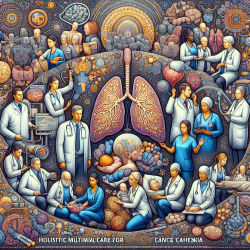Introduction
Cancer cachexia is a multifaceted syndrome characterized by severe weight loss, muscle atrophy, fatigue, and significant decline in quality of life. It affects a majority of patients with advanced-stage cancer, impacting both the patients and their family caregivers. The complexity of symptoms, which include both physical and psychological distress, necessitates a comprehensive approach to care.
Understanding Holistic Multimodal Care
Holistic multimodal care is defined as an approach that addresses not only the physical health of patients through medical, pharmacological, nutritional, and rehabilitative interventions but also considers psychological, emotional, and social well-being. This approach is patient- and family-centered, aiming to improve overall quality of life.
Despite the recognition of its importance, there is no consensus on the essential components of holistic multimodal care. However, the research article "Holistic multimodal care for patients with cancer cachexia and their family caregivers" provides valuable insights and suggests the composition of a multidisciplinary team to achieve effective interventions.
Implementing Research Outcomes
Practitioners can enhance their skills by incorporating the following strategies derived from the research:
- Multidisciplinary Team Approach: Form a team comprising oncologists, nurses, dietitians, physical therapists, psychologists, and other specialists. Each member should have a clear role, with the oncologist overseeing the team and ensuring stability in the care approach.
- Comprehensive Symptom Management: Address both physical and psychological symptoms through evidence-based interventions. This includes managing anorexia, fatigue, depression, and anxiety.
- Education and Communication: Educate patients and family caregivers about cancer cachexia, focusing on self-care strategies and nutritional guidance. Encourage open communication to address emotional distress and facilitate end-of-life discussions.
- Patient-Centered Care Plans: Develop individualized care plans that are adaptable to the changing needs of patients and their families. This includes regular assessments and adjustments to interventions.
Encouraging Further Research
While the current research provides a foundation, further studies are necessary to refine the components of holistic multimodal care. Practitioners are encouraged to engage in research activities, collaborate with academic institutions, and contribute to the development of standardized care protocols.
Conclusion
Implementing holistic multimodal care for cancer cachexia requires a concerted effort from a well-coordinated multidisciplinary team. By integrating the research outcomes into practice, practitioners can significantly improve the quality of life for patients and their caregivers. To further explore the research, practitioners are encouraged to read the original paper.
To read the original research paper, please follow this link: Holistic multimodal care for patients with cancer cachexia and their family caregivers.










